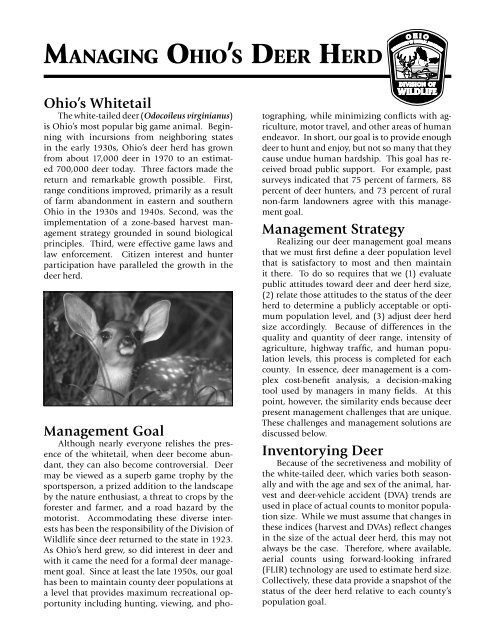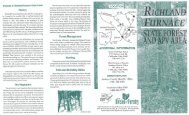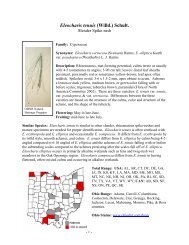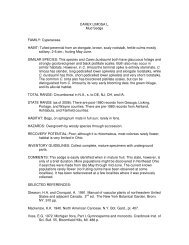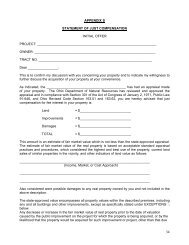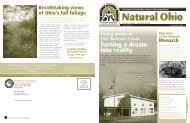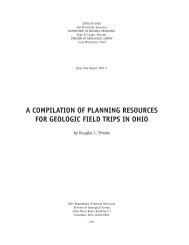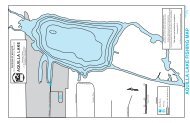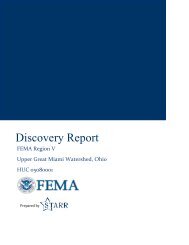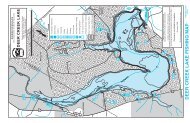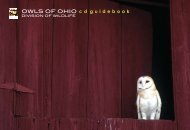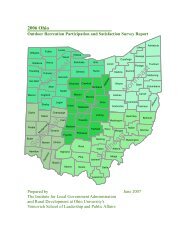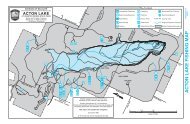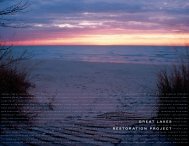Managing Ohio's Deer Herd - Ohio Department of Natural Resources
Managing Ohio's Deer Herd - Ohio Department of Natural Resources
Managing Ohio's Deer Herd - Ohio Department of Natural Resources
Create successful ePaper yourself
Turn your PDF publications into a flip-book with our unique Google optimized e-Paper software.
<strong>Managing</strong> <strong>Ohio</strong>’s <strong>Deer</strong> <strong>Herd</strong><strong>Ohio</strong>’s WhitetailThe white-tailed deer (Odocoileus virginianus)is <strong>Ohio</strong>’s most popular big game animal. Beginningwith incursions from neighboring statesin the early 1930s, <strong>Ohio</strong>’s deer herd has grownfrom about 17,000 deer in 1970 to an estimated700,000 deer today. Three factors made thereturn and remarkable growth possible. First,range conditions improved, primarily as a result<strong>of</strong> farm abandonment in eastern and southern<strong>Ohio</strong> in the 1930s and 1940s. Second, was theimplementation <strong>of</strong> a zone-based harvest managementstrategy grounded in sound biologicalprinciples. Third, were effective game laws andlaw enforcement. Citizen interest and hunterparticipation have paralleled the growth in thedeer herd.Management GoalAlthough nearly everyone relishes the presence<strong>of</strong> the whitetail, when deer become abundant,they can also become controversial. <strong>Deer</strong>may be viewed as a superb game trophy by thesportsperson, a prized addition to the landscapeby the nature enthusiast, a threat to crops by theforester and farmer, and a road hazard by themotorist. Accommodating these diverse interestshas been the responsibility <strong>of</strong> the Division <strong>of</strong>Wildlife since deer returned to the state in 1923.As <strong>Ohio</strong>’s herd grew, so did interest in deer andwith it came the need for a formal deer managementgoal. Since at least the late 1950s, our goalhas been to maintain county deer populations ata level that provides maximum recreational opportunityincluding hunting, viewing, and photographing,while minimizing conflicts with agriculture,motor travel, and other areas <strong>of</strong> humanendeavor. In short, our goal is to provide enoughdeer to hunt and enjoy, but not so many that theycause undue human hardship. This goal has receivedbroad public support. For example, pastsurveys indicated that 75 percent <strong>of</strong> farmers, 88percent <strong>of</strong> deer hunters, and 73 percent <strong>of</strong> ruralnon-farm landowners agree with this managementgoal.Management StrategyRealizing our deer management goal meansthat we must first define a deer population levelthat is satisfactory to most and then maintainit there. To do so requires that we (1) evaluatepublic attitudes toward deer and deer herd size,(2) relate those attitudes to the status <strong>of</strong> the deerherd to determine a publicly acceptable or optimumpopulation level, and (3) adjust deer herdsize accordingly. Because <strong>of</strong> differences in thequality and quantity <strong>of</strong> deer range, intensity <strong>of</strong>agriculture, highway traffic, and human populationlevels, this process is completed for eachcounty. In essence, deer management is a complexcost-benefit analysis, a decision-makingtool used by managers in many fields. At thispoint, however, the similarity ends because deerpresent management challenges that are unique.These challenges and management solutions arediscussed below.Inventorying <strong>Deer</strong>Because <strong>of</strong> the secretiveness and mobility <strong>of</strong>the white-tailed deer, which varies both seasonallyand with the age and sex <strong>of</strong> the animal, harvestand deer-vehicle accident (DVA) trends areused in place <strong>of</strong> actual counts to monitor populationsize. While we must assume that changes inthese indices (harvest and DVAs) reflect changesin the size <strong>of</strong> the actual deer herd, this may notalways be the case. Therefore, where available,aerial counts using forward-looking infrared(FLIR) technology are used to estimate herd size.Collectively, these data provide a snapshot <strong>of</strong> thestatus <strong>of</strong> the deer herd relative to each county’spopulation goal.
Optimum <strong>Deer</strong> PopulationLevelsCitizen input, as mandated by our deer managementgoal, plays a central role in the goal-settingprocess. However, the decision to maintaina deer population at a given level is not madewithout considering the potential impact thatsuch a decision might have on the whitetail, itsenvironment, and other wildlife. Technicallyspeaking, that means finding a population levelthat neither exceeds the Cultural or BiologicalCarrying Capacity.Cultural Carrying CapacityThe Division <strong>of</strong> Wildlife recognizes that all<strong>Ohio</strong>ans share the costs associated with deer.However, opinion surveys <strong>of</strong> agricultural producers,hunters, and general citizens indicate that<strong>Ohio</strong>’s farmers and motorists shoulder the greatestshare <strong>of</strong> the burden. Therefore, in 1979, webegan using periodic (~5 years) surveys <strong>of</strong> <strong>Ohio</strong>’sagricultural producers to aid us in defining optimumpopulation levels in all but our most heavilyurbanized counties. Among other things, surveyparticipants are asked if they would like tosee the size <strong>of</strong> the deer population increase, staythe same, or decrease in their area. Respondentswho preferred either an increase or decrease wereasked by what percent would they like to see thedeer population change. An average percentchange is computed for each survey region andthen applied to population estimates to derivecounty population goals.County deer population goals represent whatwe believe to be the most equitable solution tothe complex problem <strong>of</strong> minimizing impacts andmaximizing benefits derived from <strong>Ohio</strong>’s whitetaileddeer resource. Our reliance on survey inputfrom farmers, however, has drawn criticismfrom some who feel such an approach results inunnecessarily low levels <strong>of</strong> deer. Although opponentsargue that farmers generally hold a negativeopinion <strong>of</strong> deer, we found that farmers generallyvalue deer and hold opinions <strong>of</strong> deer thatgenerally are consistent with the general public.Between 40-50 percent <strong>of</strong> <strong>Ohio</strong>’s farmers surveyedindicated that they enjoy seeing and havingdeer around. An equal number enjoy deer,but worry about the problems they cause. Onlya very small percentage <strong>of</strong> farmers regard deer asa nuisance. A 1996 study from The <strong>Ohio</strong> StateUniversity revealed that <strong>Ohio</strong>’s farmers generallybelieve that the benefits <strong>of</strong> wildlife outweigh thecosts. Thus, while farmers play the largest role indeciding when enough is enough, their decisionis likely to be one most <strong>Ohio</strong>ans can support.The deer hunter also provides important inputinto the management process. In additionto voluntary comments, we poll a representativesample <strong>of</strong> deer hunters about once every fiveyears.Over 5,000 hunters representing every<strong>Ohio</strong> county are included in the survey, whichprovides information on opinions and attitudestoward season length, legal hunting devices, baglimit, hunting pressure, and deer population levels.Where appropriate, we incorporate this informationinto the deer management process.For example, a weekend firearms season wasadded to the 2006-07 season as a direct result<strong>of</strong> a 2005 deer hunter survey conducted by The<strong>Ohio</strong> State University. Among other things, thesurvey identified significant barriers to huntingparticipation. Finding time to hunt was noted bya majority <strong>of</strong> the respondents as a barrier. The additionalweekend was deemed biologically soundand as a result, hunters were given two additionaldays to hunt deer with a shotgun in <strong>Ohio</strong>.Biological Carrying CapacityAs deer approach biological carrying capacity,herd and habitat health begin to decline.Evidence that this is occurring might include adistinct browse line, the replacement <strong>of</strong> highlynutritious and preferred plant species with lesspalatable and nutritious ones, and a decline inthe condition <strong>of</strong> the animals themselves. <strong>Deer</strong>herd condition data, such as yearling (1.5-yearsold) antler beam and body weight data, collectedsince the early 1970s suggest that, while conditionin western <strong>Ohio</strong> remains unchanged, it hasdeclined in portions <strong>of</strong> eastern <strong>Ohio</strong>. This declineis a direct result <strong>of</strong> both lower habitat qualityand higher deer densities.In summary, population goals are set for eachcounty based largely on preferences <strong>of</strong> our agriculturalproducers. These goals may be adjustedas deer herd condition changes. We believe thatsuch an approach goes the furthest toward achieving<strong>Ohio</strong>’s publicly approved deer managementgoal. The concept <strong>of</strong> optimum population levelsis an important one because it provides the Division<strong>of</strong> Wildlife with management direction.
Harvest ManagementThe high quality <strong>of</strong> <strong>Ohio</strong>’s deer range and virtualabsence <strong>of</strong> natural predators, coupled withthe whitetail’s remarkable reproductive potential,dictate harvest management as the most practicalmeans <strong>of</strong> maintaining deer populations nearcounty population goals. Regulations can be effectivelyused to increase, decrease, or maintainharvests <strong>of</strong> either or both the antlered and antlerlesssegments <strong>of</strong> the population. For instance,a buck-only harvest regulation was used from1965-73 to foster deer herd growth. In 1973,antlerless (does and fawn bucks) permits were issuedin limited numbers to slow herd growth inportions <strong>of</strong> the state. By 1979, all <strong>of</strong> <strong>Ohio</strong>’s 88counties were open to gun hunting and in 1984,an either-sex regulation replaced limited antlerlesspermits in many counties to further slowherd growth. Despite these changes, <strong>Ohio</strong>’s deerherd continued to grow. In 1991, bag limit increasesfrom one to two deer (the additional deerwas antlerless) were instituted in many counties.Other tools have been used as well including seasonlength extensions, new seasons, and specialhunting zones and bag limits. The status <strong>of</strong> thedeer population relative to goal, as well as experiencewith past harvest regulations, determinewhich tools are used in a given county each year.In counties where populations are above goal,liberal harvest regulations are used to reduce deernumbers. The opposite applies in counties belowgoal. Ultimately, population levels are controlledby regulating the harvest <strong>of</strong> females, which typicallyrepresent about 75 percent <strong>of</strong> the antlerlessharvest.The effectiveness <strong>of</strong> our harvest managementsystem will vary somewhat from year to year dependingon a host <strong>of</strong> factors including hunterparticipation and weather during the firearmsseasons. These variables and many others thatinfluence harvest are <strong>of</strong>ten difficult or impossibleto quantify. Consequently, an over or under harvestin a particular county is a fact <strong>of</strong> life. This canbe compensated for in subsequent years, however,by adjusting the harvest regulations accordingly.We expect that over the long-term, the number<strong>of</strong> deer in the state (and in most counties) canbe maintained near the desired level with sucha system. This system works best, however, onlywhen <strong>Ohio</strong>’s deer hunters and landowners participatefully.Successful management <strong>of</strong> <strong>Ohio</strong>’s deer herdrequires a cooperative effort among <strong>Ohio</strong>’s huntersand landowners to eliminate obstacles thatcurrently limit the effectiveness <strong>of</strong> our managementapproach. These obstacles include a reluc-Number <strong>of</strong> <strong>Deer</strong>120,000100,00080,00060,00040,00020,000Statewide <strong>Deer</strong> Population Trends as Indicated byAntlered Buck Harvest and <strong>Deer</strong>-vehicle Accidents3.02.52.01.51.00.5Reported Accidents per 1,000 Registered Vehicles01990 1992 1994 1996 1998 2000 2002 2004 2006YearAtlered Buck Harvest<strong>Deer</strong>-vehicle Accidents0.0
tance on the part <strong>of</strong> hunters to abandon traditionalsites and seek areas with lower access andhigher deer densities and a reluctance on thepart <strong>of</strong> landowners to grant access to their lands.Hunters must work harder to cultivate positivelandowner-hunter relationships.Landownerscan help by allowing deer hunting and activelyrecruiting good deer hunters. Additionally, landownersare encouraged to take an active role inthe management <strong>of</strong> the deer on their property byimplementing their own “harvest management”guidelines. If herd reduction is the goal, it maybe appropriate to limit the harvest to antlerlessdeer or use an “earn-a-buck” strategy, wherebyonly those hunters harvesting antlerless deer firstwould be able to harvest a buck. A good rule<strong>of</strong>-thumbis that landowners annually need toharvest 35 percent <strong>of</strong> the deer they believe areon their property and about 75 percent <strong>of</strong> theseshould be antlerless deer. In so doing, landownerswill be managing for stable deer populations.Otherwise, reduced harvests will result in increasingherd size.Special ManagementTechniques for Urban andAgricultural ProblemsBy managing for optimum deer populationlevels on a county basis, we expect to prevent oreliminate widespread agricultural problems withdeer. However, some localized crop damage isstill likely to occur. Even with a county populationat goal, deer will move to and concentrate inareas <strong>of</strong> good habitat. Farm fields and orchardsin proximity to good deer cover are especiallyvulnerable.In situations where deer need to be killed toreduce property damage, landowners or lesseesmay be issued <strong>Deer</strong> Damage Control Permits(DDCP) at the time the damage is occurring.These permits allow landowners/lessees and theiragents to kill deer during the dates and under theconditions specified on the permit. For most agriculturalproblems, these permits will only bevalid for the period <strong>of</strong> January 1 until the start <strong>of</strong>the archery season. Under limited crop damagecircumstances, permits may be extended untilthe start <strong>of</strong> the youth gun season. In specific circumstances,permits may be valid year-round tocontrol damage at orchards, nurseries, inside municipalities,and for safety purposes at airports.Regardless <strong>of</strong> the situation, DDCPs will expire nolater than December 31 <strong>of</strong> the year in which thepermit is issued. Except in the case <strong>of</strong> rub damageto trees, permit holders are strongly encouragedto kill antlerless deer. Permit holders mustsurrender all antlers to the Division <strong>of</strong> Wildlife.Additional information about this program canbe obtained from your local state wildlife <strong>of</strong>ficeror by writing to the Division <strong>of</strong> Wildlife, WildlifeManagement and Research, 2045 Morse Road ,Columbus, <strong>Ohio</strong> 43229-6693. Information isalso available by calling 1-800-WILDLIFE.In response to increasing numbers <strong>of</strong> deervehicleaccidents and low harvests, the Division<strong>of</strong> Wildlife established five Urban <strong>Deer</strong> Zonesencompassing all or portions <strong>of</strong> 19 urban countiesin 1994. Local ordinances permitting, hunterscould harvest two additional antlerless deerwithin the Urban <strong>Deer</strong> Zones. In 1995, the baglimit was doubled. Permit sales and harvest increased378 percent and 28 percent, respectively.Publication 87 (R408)An Equal Opportunity Employer - M/F/HTed Strickland, Governor • Sean D. Logan, DirectorDavid M. Graham, Chiefwww.wildohio.com1-800-POACHER


